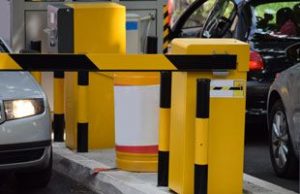For the past century or more, space for vehicle storage has been at a premium in urban environments. As cars became more common around the beginning of the 20th century and the world began an urbanization trend, competition for space in cities increased.
This article will examine the history and evolution of solutions to that dilemma, including but not limited to smart parking systems that, in today’s parlance, are generally considered to be those where drivers park their own cars. These solutions are currently the pinnacle of the evolution of parking systems, as management of space allocation and charging drivers for their use of the space is automated, so no human attendants are required. Most such systems are based on ANPR (automatic number plate recognition) cameras.
We’ll get back to a discussion of those relatively modern systems and their history. First, though, we’ll explore automated parking systems (APS) of different types, particularly those operated without driver involvement that, in most cases, had less capacity than modern high-rise parking garages.
The First Automated Parking Systems
The Garage Rue de Ponthieu in Paris was built in 1905. A multi-level concrete structure incorporated internal elevators to move cars up and down to and from the various levels where attendants parked the cars. The elevators saved the space that many garages now occupy with ramps.
In the 1920s, a system called the Paternoster became popular. It was a sort of Ferris wheel type of arrangement occupying the footprint of two cars, but usually with the capacity of eight cars. A chain was routed over sprockets at the top of the structure and under the floor, and compartments attached to the chain each held one vehicle. The compartments became accessible at the floor level in succession as the chain rotated over the sprockets.
About the same, a system called the Kent Automatic Garages gained popularity. In this arrangement, an electric “parker” lifted the rear wheels of a car and moved it to or from an available space using an elevator to move among levels in the garage. One of the first of these was installed in New York in 1928. It worked pretty efficiently, parking and retrieving cars in as little as 15 seconds, depending on the level of the space they occupied in the 1,000-car facility.
As larger cars became the norm after WWII, these garages became obsolete, and most were converted to office space or were demolished.
Continuing History of APSs
A ten-year span in the late 1940s and early 1950s saw a spurt of interest in APSs in the U.S. In 1957, 74 Bowser, Pigeon Hole, and Roto Park systems were built. As the systems experienced mechanical problems and people became impatient with long waits for their cars, their popularity waned.
In London, the Auto Stacker system opened in 1961, though it soon developed similar difficulties to the U.S. systems.
There was a lull in interest in APSs in the U.S. until the early 1990s. However, Europe, Asia, and Central America saw many systems beginning in the 1970s. The Paternoster systems we described earlier regained interest in Japan, and spaces for a total of about 40,000 cars using that system were built annually from the early 1990s and over the next twenty years.
Currently, the largest APS is in Kuwait, with a capacity of 2,314 cars. The largest APS in Europe is in Denmark, capable of handling 1,000 vehicles simultaneously and using 20 elevators.
ANPR-Based Smart Parking Systems As We Know Them Today
While APS systems save space and have other advantages, they are unsuited for high peak volumes, such as city rush hours or event stadiums. Sequential parking and retrieval of cars take too long for these applications.
Multi-level self-parking systems are the norm in high peak volume applications. The most effective smart parking systems for self-parking garages use ANPR cameras. However, some, mostly older, facilities use RFID chips or QR codes in plastic cards or stickers attached to the car.
ANPR cameras have several advantages over the electronic code-based systems:
- Nothing has to be attached to the car, so any vehicle can be accommodated, whether an occasional user with no contract or someone who parks there every day. Those without a prearranged relationship must take a time-stamped card and pay when they exit in a code-based system, and this process takes time.
- There is no need for cars to come to a full stop when they enter the garage. This speeds up flow and reduces or even eliminates congestion on the street, to the delight of parkers, traffic authorities, and passing motorists.
- ANPR-based smart parking systems can easily accommodate advance reservations from anywhere in the world. When someone makes a reservation to park, they enter their license plate number. When they arrive to claim their reserved spot, the system immediately recognizes them and admits them to the facility.
ANPR cameras have been used in smart parking systems since the early 21st century and have become a mainstay in modern parking management. By all indications, they will continue to figure in more advanced smart parking systems.
Many different types of parking systems with varying degrees of automation have been tried and used since motorization became part of our lives. Since the early 21st century, ANPR-based smart parking systems have dominated the industry, and the flexibility they offer is hard to beat. When a camera has recorded a plate number and identified the vehicle and person associated with it, that data can be used in many ways, including parking management.
Adaptive Recognition offers the highest quality and most flexible plate recognition technology available. To learn more and discuss your parking system needs, check out their website or contact one of their experts.













